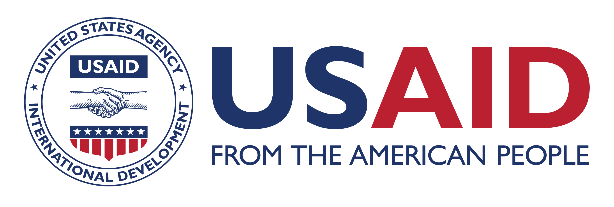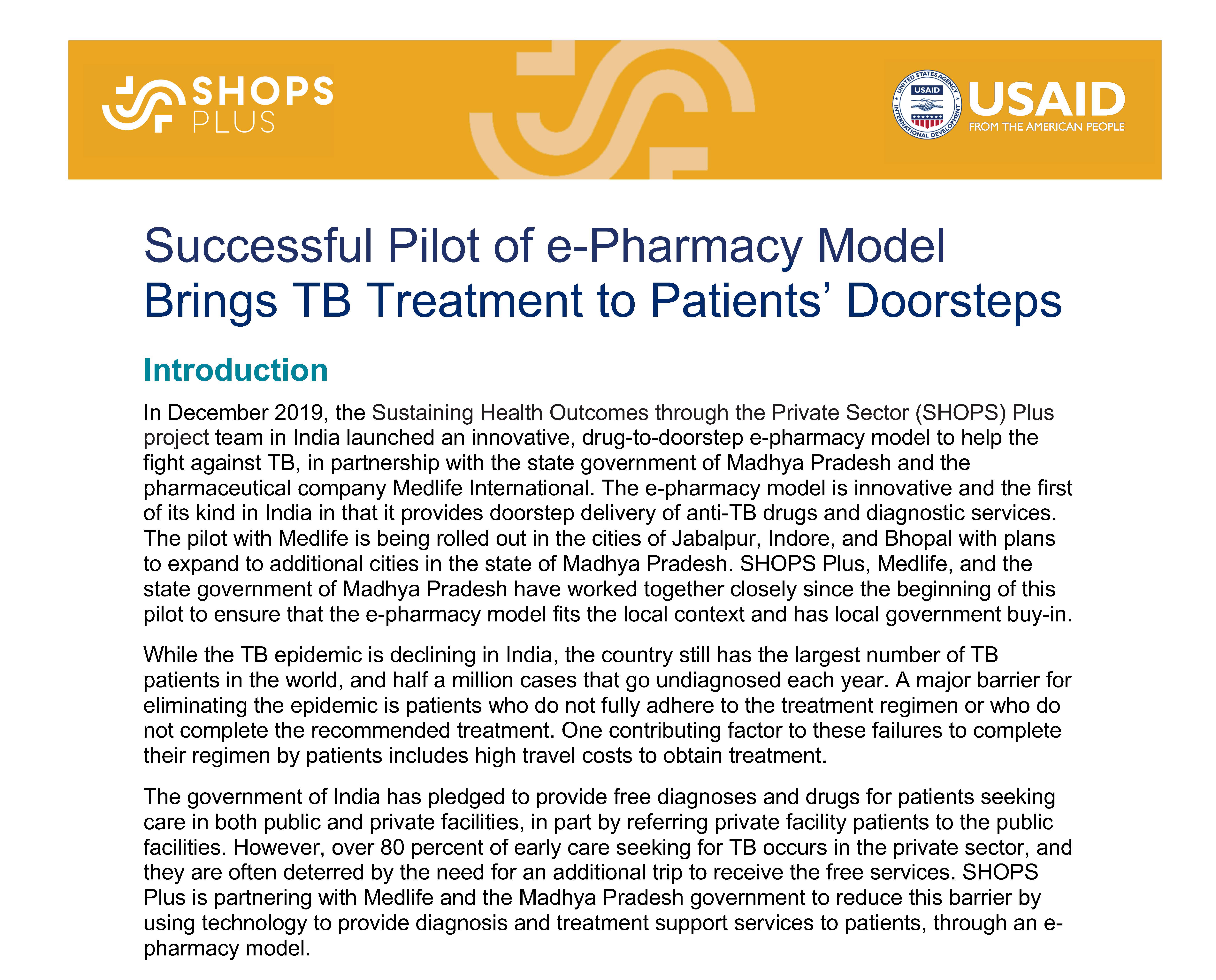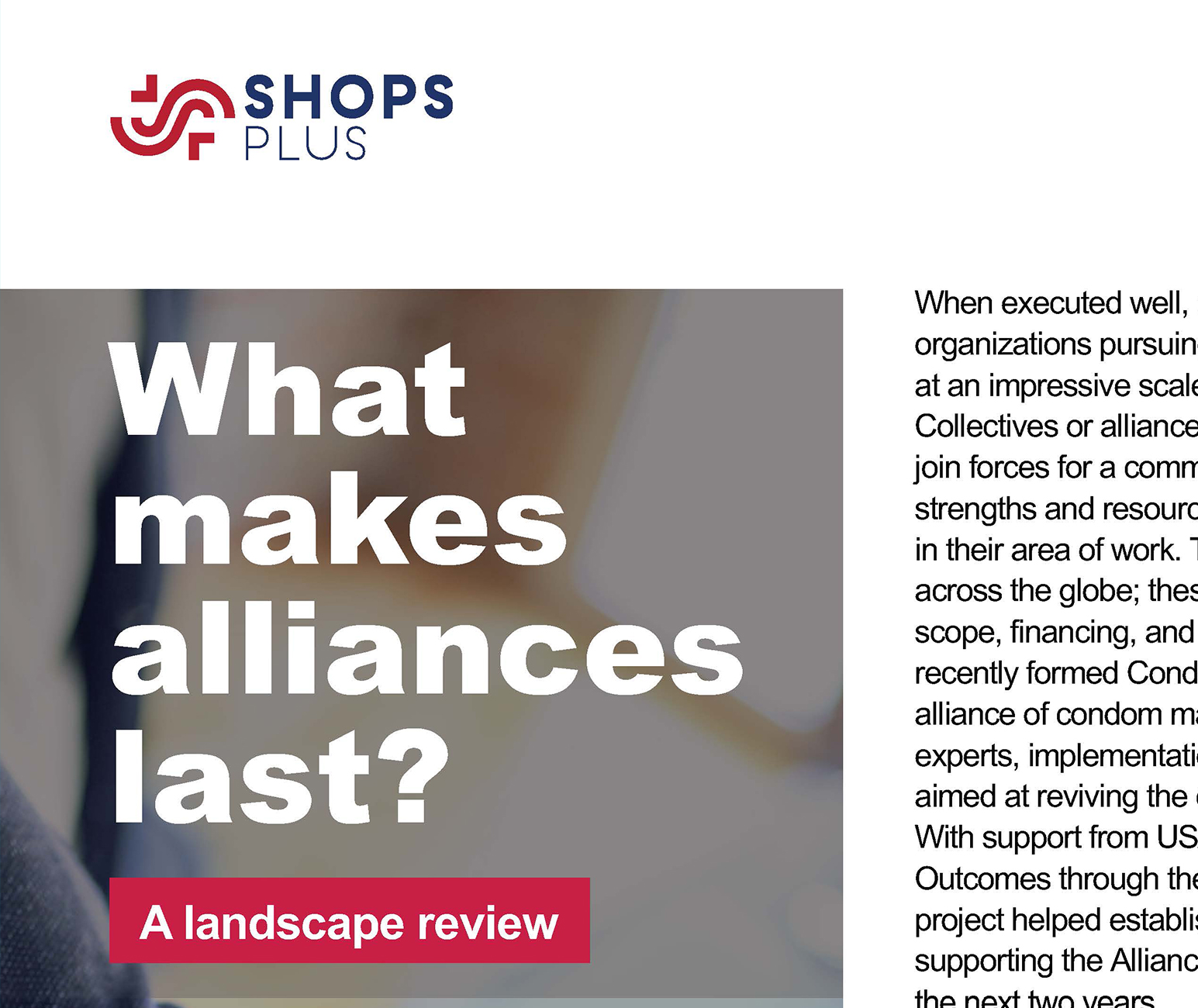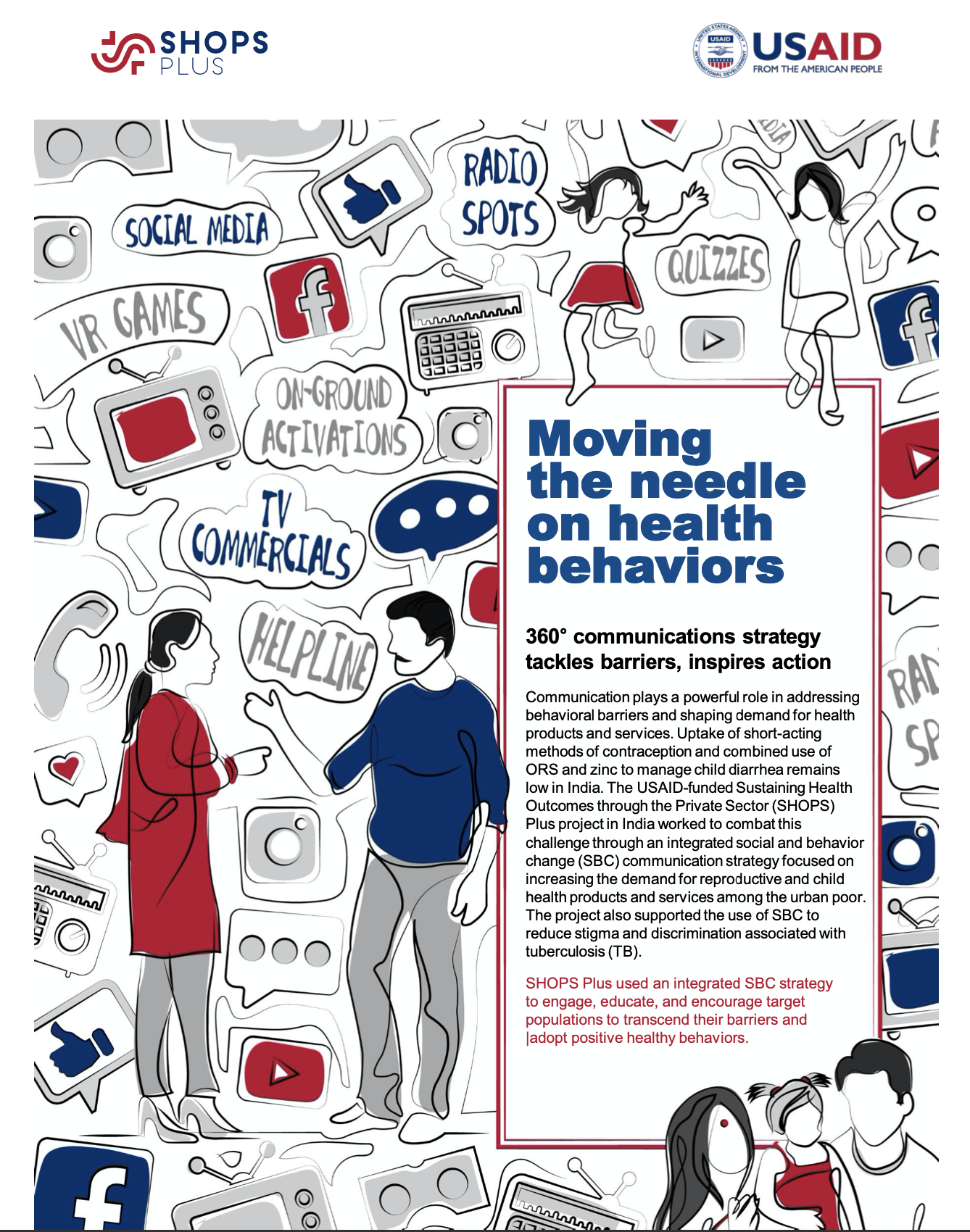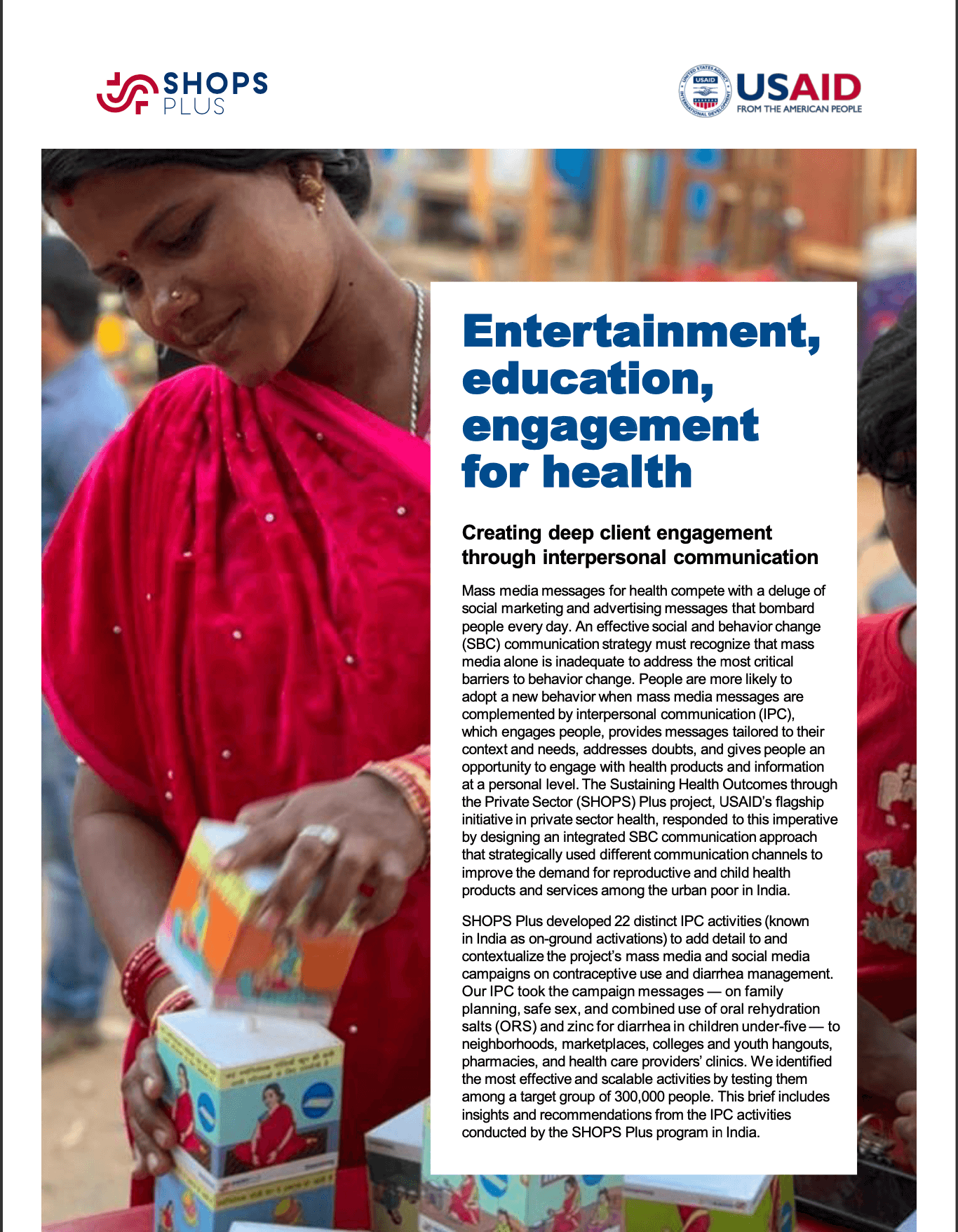
Resource Library
Successful Pilot of e-Pharmacy Model Brings TB Treatment to Patients' Doorsteps
In December 2019, the SHOPS Plus project team in India, in partnership with the state government of Madhya Pradesh and the pharmaceutical company Medlife International, launched an innovative, drug-to-doorstep e-pharmacy model to help the fight against TB. In the e-pharmacy model, private providers can prescribe home sputum testing materials to presumptive TB patients. The test is completed in the comfort of the patient’s own home, and e-pharmacy agents will pick up the materials and deliver them to the lab facility. The lab uploads the results to the government’s online platform where providers can view results and prescribe treatment. Once the prescription is verified by the e-pharmacy, agents deliver the drugs directly to the patient’s home. This brief shares the findings and lessons learned from the pilot program.
Resource Type : Brief
Country : India
Year : 2021-08-13T13:30:00
Language : English
Project : SHOPS Plus

Resource Library
SHOPS Plus: Collaborating for Greater Efficiency and Impact
India shoulders a huge TB burden—24 percent of global prevalence and 21 percent of global TB deaths. The government of India has committed to making India TB-free by 2025. The country’s Ministry of Health and Family Welfare has galvanized its efforts through the National TB Elimination Program, which leads TB activities in the country and provides various free TB services through the public health system. A major challenge for India is tackling TB in urban areas, especially in urban slums, where crowded living conditions and limited access to TB services result in TB cases being nearly three times higher than the national average. In addition, overburdened public health facilities with weak referral and outreach systems, and high out-of-pocket expenditure in private facilities further constrain access to TB services. SHOPS Plus worked to integrate the National TB Elimination Program’s TB services into the government’s network of health facilities to reach every person in need.
Resource Type : Brief
Country : India
Year : 2021-07-19T14:59:03
Language : English
Project : SHOPS Plus

Resource Library
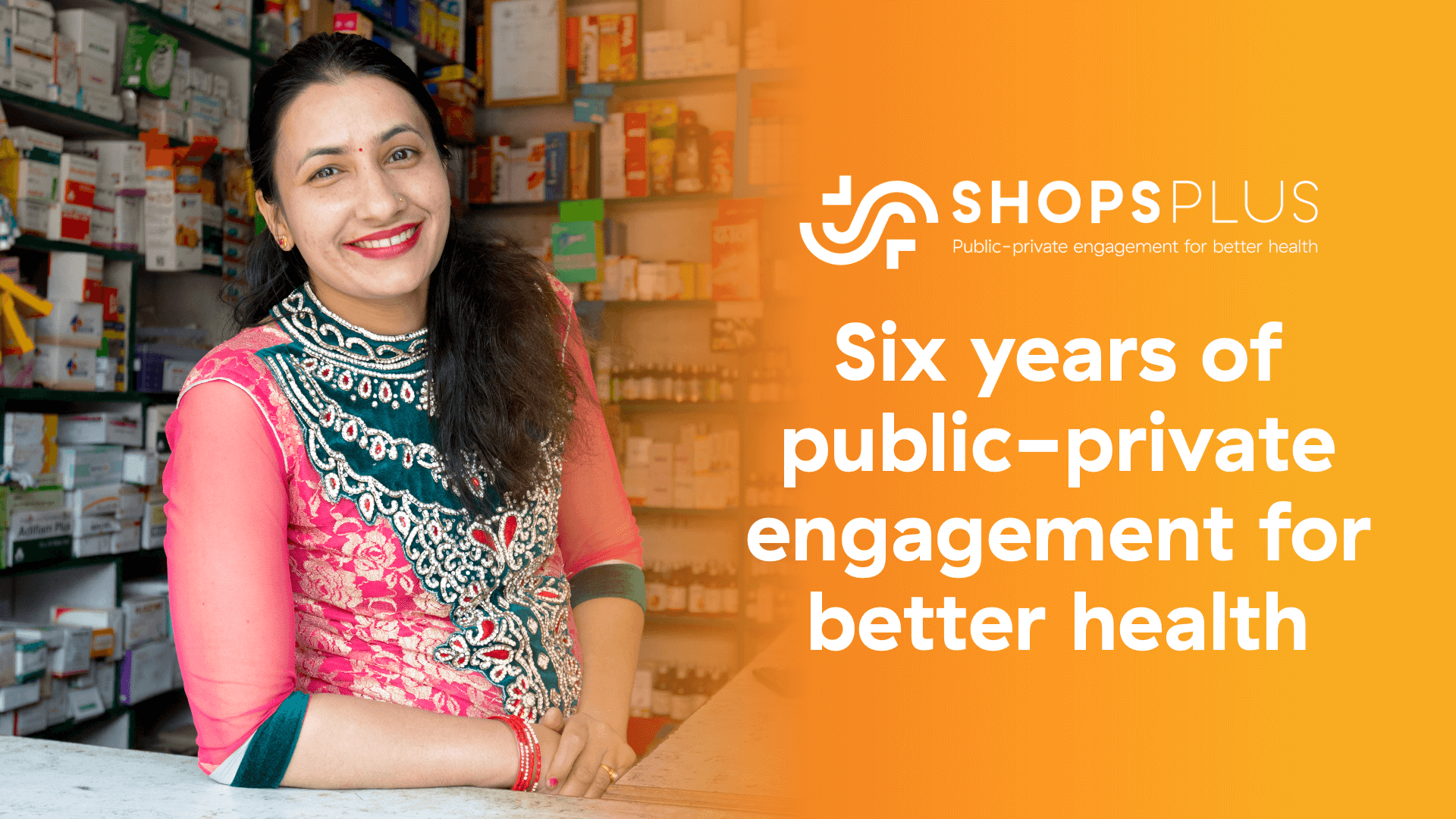
Video: Highlights from SHOPS Plus - Six years of public-private engagement for better health
Watch highlights from six years of SHOPS Plus engaging the private sector in health.
The video was shown July 14, 2021, during the webinar “Accelerating private sector engagement: What the future holds.”
Resource Type : Video
Country : India, Kenya, Madagascar, Nepal, Nigeria, Rwanda, Senegal, Tanzania
Year : 2021-07-15T12:30:00
Language : English
Project :

Resource Library
What makes alliances last?
When executed well, coordinated action by organizations pursuing a shared goal can effect change at an impressive scale and yield inspiring results. Collectives or alliances allow multiple stakeholders to join forces for a common goal, leveraging their diverse strengths and resources to play a more influential role in their area of work. There are thousands of alliances across the globe; these vary widely in purpose, size, scope, financing, and impact. One such alliance is the new Condom Alliance in India—the country's first alliance of condom manufacturers, marketers, domain experts, implementation agencies, and donors—aimed at reviving the condom market in the country. With support from USAID, SHOPS Plus helped establish the Condom Alliance and is supporting the alliance to think through its strategy over the next two years.
In an effort to inform the alliance’s potential paths to sustainability, SHOPS Plus conducted a landscape review to understand what makes an alliance sustainable. This brief shares findings on best practices for ensuring a sustainable alliance and highlights examples of existing alliances most relevant to the Condom Alliance as it evolves.
Resource Type : Brief
Country : India
Year : 2020-12-31T08:00:00
Language : English
Project : SHOPS Plus

Resource Library
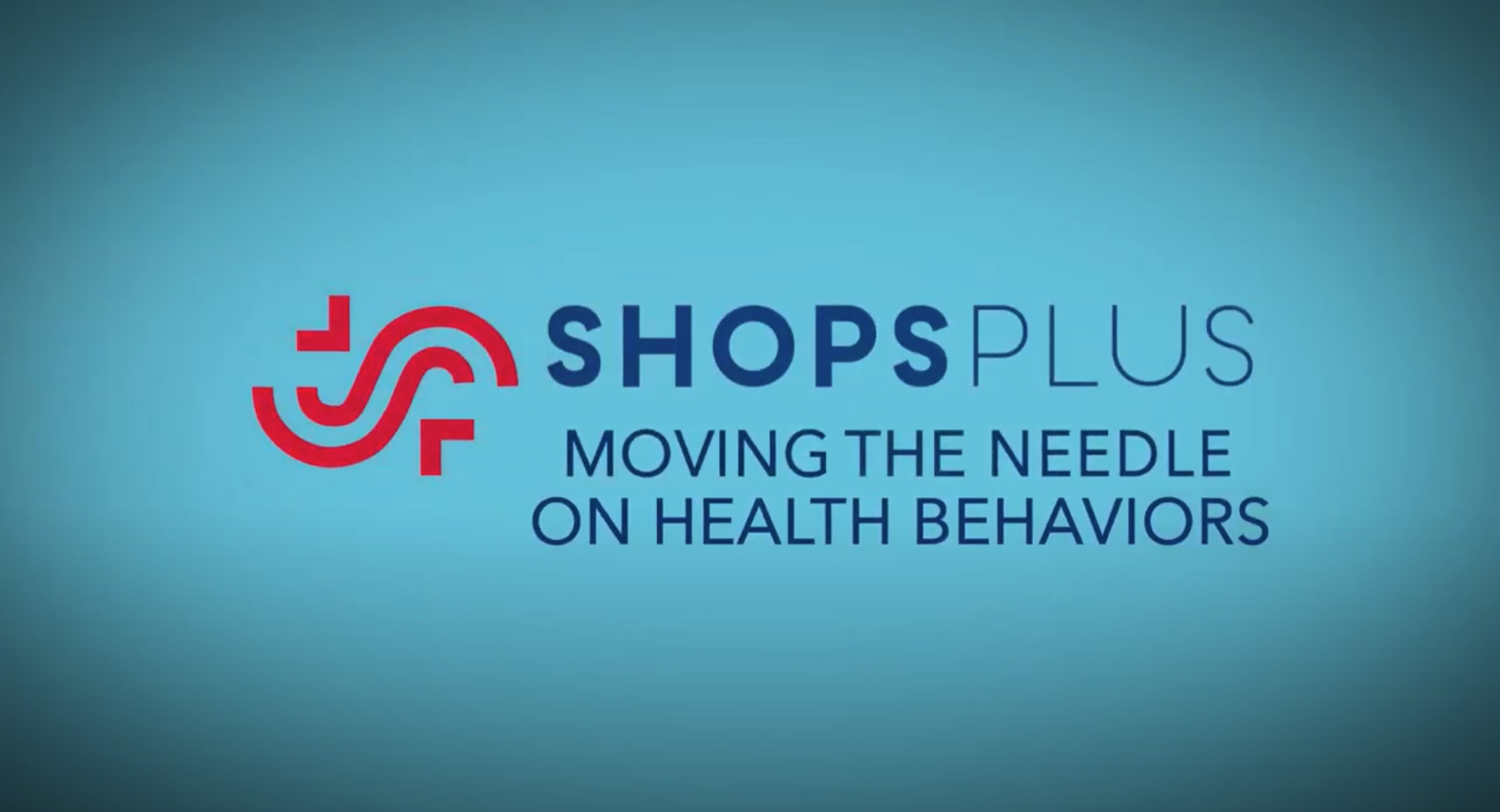
Video: Moving the Needle on Health Behaviors
The video covers how the power of informed messaging can effectively reach youth. They are an audience that often harbors myths and misconceptions surrounding family planning, maternal and child health, and tuberculosis. Effective messaging can create meaningful change in attitudes and behaviors towards these health topics.
Related stories and resources:
- Brief: Moving the needle on health behaviors
- Story: Creating real-time client engagement in India
- Story: HelloJubi answers questions and dispels myths on health topics
- Photo story: Making behavior change fun
50 Shades of Ishq
Khushiyon ki Shuruaat
Resource Type : Video
Country : India
Year : 2020-10-16T12:00:00
Language : English
Project :

Resource Library

Webinar: Catalyzing Public-Private Engagement to Strengthen Health Outcomes in India (recording)
On September 4, the SHOPS Plus project in India held a webinar to discuss how the project fostered relationships between public sector and private sector actors to create shared ownership, collective impact, and sustained health outcomes.
USAID considers engaging both private and public sector actors as a key aspect of India’s journey to self-reliance. This webinar focused on two public-private partnerships with guest speakers representing each player. One of the two examples was a Defeat Diarrhea campaign that included India’s Ministry of Health and Family Welfare, and major ORS manufacturer, Dr. Reddy’s. The other example was a TB e-pharmacy pilot that partnered Madhya Pradesh state government with India’s largest online pharmaceutical company, Medlife.
Speakers
- Moni Sagar, Division Chief, Family Health Division - USAID India
- Dr. Ajay Khera, Country Representative - Engender Health India (former Commissioner, MoHFW - Government of India)
- Komal Khanna, Chief of Party, SHOPS Plus India, Abt Associates
- Sriprasad T G, Senior Director-Customer Experience, Medlife
- Dr. Sanjay Pandey, Chief Officer, Advocacy and Partnership - Population Services International India
Moderator
- Abhilash Philip, Deputy Chief of Party, SHOPS Plus India, Abt Associates
Resource Type : Webinar
Country : India
Year : 2020-09-14T12:00:00
Language : English
Project :

Resource Library

Webinar: On-Ground Activations in India: Creating real-time client engagement (recording)
SHOPS Plus has piloted innovative interpersonal communication activities, also called on-ground activations (OGAs), to improve the demand for reproductive and child health products and services among the urban poor in India. This program has highlighted the importance of OGAs as an essential component of social and behavior change.
When mass media messages are complemented by OGAs, people are more likely to adopt a new behavior. This is especially true when the OGAs engage people, provide tailored messages, address doubts, and give people an opportunity to engage with health products and information.
On July 2, the SHOPS Plus team in India hosted a webinar on how to leverage community and facility-based approaches, and featured corporate and non-governmental partners who shared why they believe so strongly in these OGAs.
Speakers
- Ashok Raisinghani, Technical Specialist – Abt Associates
- Sushil Patil, Group Product Manager – FDC
- Mayank Dabral, Director – Impact Code
Moderator
- Abhilash Philip, SHOPS Plus Deputy Chief of Party
Resource Type : Webinar
Country : India
Year : 2020-07-02T12:00:00
Language : English
Project : SHOPS Plus

Resource Library
Moving the needle on health behaviors
Communication plays a powerful role in addressing behavioral barriers and shaping demand for health products and services. Uptake of short-acting methods of contraception and combined use of ORS and zinc to manage child diarrhea remains low in India. The SHOPS Plus program in India worked to combat this challenge through an integrated social and behavior change communication strategy focused on increasing the demand for reproductive and child health products and services among the urban poor. The project also supported the use of SBC to reduce stigma and discrimination associated with tuberculosis.
Resource Type : Brief
Country : India
Year : 2020-06-15T12:00:00
Language : English
Project : SHOPS Plus

Resource Library
Entertainment, education, engagement for health
Mass media messages for health compete with a deluge of social marketing and advertising messages that bombard people every day. An effective social and behavior change communication strategy must recognize that mass media alone is inadequate to address the most critical barriers to behavior change. People are more likely to adopt a new behavior when mass media messages are complemented by interpersonal communication, which engages people, provides messages tailored to their context and needs, addresses doubts, and gives people an opportunity to engage with health products and information at a personal level. SHOPS Plus responded to this imperative by designing an integrated social and behavior change communication approach that strategically used different communication channels to improve the demand for reproductive and child health products and services among the urban poor in India.
Resource Type : Brief
Country : India
Year : 2020-06-15T12:00:00
Language : English
Project : SHOPS Plus

Resource Library
Innovative Prototypes to Promote Condom Use among Youth
Innovative Prototypes to Promote Condom Use among Youth
In India, the use of condoms is low, in spite of relatively high awareness of this method. To increase the uptake of condoms, SHOPS Plus India developed innovative prototypes to promote the use of condoms, using a design thinking approach with a behavioral economics lens. The activity targeted youth 18 - 24 years of age, in the two project cities of Delhi and Bhubaneshwar.
Introduction
Design thinking is an approach which follows key design principles – including empathy with users, a discipline of prototyping and tolerance for failure1 - to develop innovative ideas that work in the real world. Design thinking goes beyond human-centered design (which considers the real needs and desires of people in the design of an idea) by also considering the feasibility of that idea, and its viability for scale-up. The field of behavioral economics seeks to understand how people make decisions, through the lens of psychological, behavioral, emotional and social factors. It posits that people act in irrational—albeit predictable—ways, in contrast to standard economics, where people are assumed to make rational decisions. Applying a behavioral economics lens in this activity helped the project to understand the nuances of the decisionmaking process around condom use, and the design thinking approach provided an overall framework for the development and testing of innovative prototypes in a real-world setting.
The activity was conducted in three design-thinking phases (see figure below): 1) empathizing with youth (between 18-24 years of age) to understand barriers and drivers to condom use and to define problem statements; 2) brainstorming to develop innovative solutions and prototypes, and 3) testing and refining of select prototypes. Stakeholders involved in this activity included youth, pharmacists/shopkeepers selling condoms, condom manufacturers and marketers, and USAID India.
Phase 1
The first phase commenced with qualitative research among youth to understand barriers and drivers to condom use, and to map the ‘user journey’ - the thoughts, feelings, and subconscious emotions of someone planning to have sex. This journey starts with a conversation around intimacy, includes a decision point on whether or not to buy a condom including which one to buy, who buys, where to buy, and ends with the couple parting ways after their encounter. Insights from this decision-making journey were used in a co-creation workshop to brainstorm and define key problem statements that capture barriers to condom use.
Phase 2
In the second phase of the activity, the key problem statements were shared in a workshop setting as a basis to brainstorm and create innovative solutions to the identified problems. During brainstorming, participants considered ‘extreme users’ – those who had never used a condom before, and those who were experienced users – with an eye on arriving at solutions that could address the needs of all users - on both extremes, and in between. This workshop, which leveraged perspectives and experiences of stakeholders from diverse backgrounds (including youth), led to the generation of nearly 200 solutions to address the problems defined in the first phase. The solutions were grouped into 11 broad buckets such as “making it easier for women to purchase condoms” and “triggering consent-seeking before the sexual act”. These 200 innovative solutions were shortlisted through consultation with condom manufacturers, marketers, and SHOPS Plus technical staff. A shortlist of 33 solutions, ranging from nontraditional packaging of condoms to innovations at pharmacies, were then rapidly prototyped in preparation for testing.
Phase 3
In the third phase of the activity, prototypes were tested with actual users in both controlled and natural environments to obtain feedback on what worked for them and what didn’t. ‘Live’ testing enabled the team to analyze the findings based on what users did (in reaction to the prototype), in addition to what they said when interviewed. Prototypes that received more positive feedback were tweaked and re-tested over several iterations, to finally arrive at a set of refined solutions that addressed desirability to users and feasibility based on testing with pharmacists/shopkeepers and manufacturers. The most promising prototypes (those that ranked highly on desirability and feasibility) were shared with condom manufacturers and partners to obtain their feedback on the viability of the prototypes for scale-up. Ultimately, the prototypes that ranked highly on desirability, feasibility and viability for scale-up were handed over to condom manufacturers and partners, to be adopted by them, for further refinement and testing as they deem appropriate.
This activity was planned with key stakeholders - condom manufacturers and marketers - involved in critical phases of the activity. They participated in the prioritization of key problem statements at the end of Phase 1, the shortlisting of solutions in Phase 2, and providing feedback on the viability of prototypes in Phase 3. Their involvement has resulted in prototypes that reflect their interests and priorities, and therefore are more likely to be adopted by them.
This design thinking and behavioral economics approach may be useful in other contexts, health or otherwise, where behavior change is challenging to achieve and where efforts to promote behavior change could benefit from the development of innovative, ‘real-world-tested’ solutions that address potentially invisible barriers among end-users.
SHOPS Plus India Formative Evaluation of Innovative Condom Interventions research study page.
Resource Type : Brief
Country : India
Year : 2020-03-30T12:00:00
Language : English
Project : SHOPS Plus
Pagination
- Previous page
- Page 4
- Next page

